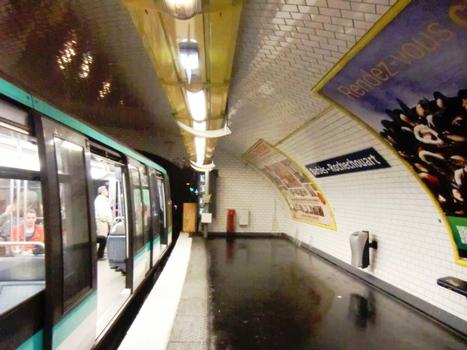General Information
| Completion: | 21 April 1908 |
|---|---|
| Status: | in use |
Project Type
| Structure: |
Underground structure |
|---|---|
| Function / usage: |
Below grade metro or light-rail station |
Location
| Location: |
Paris ( 9th), Paris, Ile-de-France, France Paris (10th), Paris, Ile-de-France, France Paris (18th), Paris, Ile-de-France, France |
|---|---|
| Part of: | |
| Coordinates: | 48° 53' 1" N 2° 21' 2" E |
Technical Information
There currently is no technical data available.
Excerpt from Wikipedia
Barbès–Rochechouart (French pronunciation: [baʁbɛs ʁɔʃ(ə)ʃwaʁ]) is a station on Line 2 and Line 4 of the Paris Métro. Situated at the location where the 9th, 10th and 18th arrondissements all share a border point, the station is at the junction of Boulevard Barbès, named for the revolutionary, Armand Barbès, the Boulevard de Rochechouart, named for the abbess, Marguerite de Rochechouart, Boulevard de la Chapelle and Boulevard de Magenta.
Location
The station is located at the intersection of four boulevards: Boulevard de Magenta, Boulevard de la Chapelle, Boulevard Barbès and Boulevard Marguerite-de-Rochechouart.
The station is the former location of the Barrière Poissonnière, a gate in the Wall of the Farmers-General built for the collection of excise taxes (the octroi). The gate was built between 1784 and 1788, and it was demolished in the nineteenth century.
History
The elevated Line 2 station was opened on 31 January 1903 as Boulevard Barbès station, as part of the extension of Line 2 from Anvers to Bagnolet'(now called Alexandre Dumas). It was renamed to its current name eight days later. Line 2 descends into a tunnel to the west of the station. The underground Line 4 station was opened on 21 April 1908 as part of the first section of the line from Châtelet to Porte de Clignancourt.
The disastrous fire of 10 August 1903 that resulted in eighty deaths at Couronnes station began at Barbès–Rochechouart. During World War II, on 21 August 1941, Pierre Georges and three companions of the French Resistance shot and killed a German naval cadet named Alfons Moser when he was boarding a train at the Barbès station at eight in the morning. The killing was in revenge for the execution of Samuel Tyszelman for taking part in an anti-German demonstration. This was the start of a series of assassinations and reprisals that resulted in five hundred French hostages being executed in the next few months.
During work carried out in 1987, the Hector Guimard's entrance was transferred to the Bolivar metro station. The station was renovated in 1998.
On 2 December 2016, a train derailed at the station, with no casualties but blocked traffic for 48 hours on part of the line. The derailment was caused by the fall of an inverter boot from the train, located under the body of car.
In 2019, 7,974,496 travelers entered this station which placed it at the 29th position of the metro stations for its usage.
Passenger services
Access
Access to the Barbès-Rochechouart metro station is located on Boulevard Marguerite-de-Rochechouart, Boulevard Barbès and Boulevard de la Chapelle at the limit of the 9th, 10th and 18th arrondissements of Paris.
Platforms
The two lines have standard configuration stations with two platforms framing the two tracks.
The station of line 2 is elevated, located on a viaduct which ends shortly after leaving the station in the direction of Porte Dauphine. The platforms of line 4 are underground and curved. In the direction of Porte de Clignancourt, it is possible to see the Château Rouge station.
As part of the automation of line 4, its station is being modernized, leading to the removal of its Ouï-dire style. Its platforms have been raised to accommodate landing doors.
Text imported from Wikipedia article "Barbès–Rochechouart (Paris Métro)" and modified on 21 February 2022 according to the CC-BY-SA 3.0 license.
Participants
Currently there is no information available about persons or companies having participated in this project.
Relevant Web Sites
- About this
data sheet - Structure-ID
20051469 - Published on:
08/01/2010 - Last updated on:
05/09/2014






